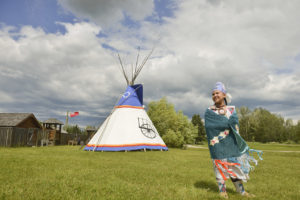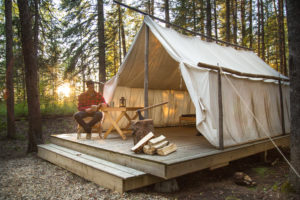Interview: Susan Kennard, Parks Canada
As part of an ongoing collaboration, Parks Canada Agency staff graciously agreed to lend their marketing and community engagement expertise to the National Trust for Canada’s Marketing Your Historic Destination Tool Kit. The following is an interview with Susan Kennard, Manager of Heritage Programs for the Banff Field Unit, which includes Rocky Mountain House National Historic Site.
Interview
Susan Kennard, Manager of Heritage Programs for the Banff Field Unit, Parks Canada
Rocky Mountain House National Historic Site is one of Canada’s fine examples of how the fur trade helped shape the nation. Visitors can enjoy exhibits, walk through archaeological remains of the four forts and get hands on experience with Métis skills of the fur trade. As a member of the Banff Field Unit Management team Manager, Susan Kennard is responsible for setting the sites strategic and long term direction which includes visitor experience planning, cultural resource management and capacity building at the operational level.

01. Susan, can you tell us about your partnership with the Indigenous communities in your area? How do you partner? And, how do you make the relationship work?
We have a number of Indigenous and Métis partnerships at the Rocky Mountain House National Historic Site. The longest running one is with the Métis Local 845. We have a contract for services with them as well as a Memorandum of Understanding (MOU). The MOU captures the spirit of the relationship. We are collaborators, partners and independent of one another, yet working towards similar goals: sharing staff training; contributing to the visitor experience and learning; furthering Canadians and international visitors’ knowledge of Métis culture past and present; and exploring market opportunities for Indigenous Tourism. The contract defines the details of the program the Métis Local runs at the site during our summer season which is a Métis cultural demonstration camp matching the same operating hours as the National Historic Site.
We have other MOU’s in place with a variety of Indigenous organizations including the Rocky Native Friendship Centre and the Kis Sai Wah Toe Tat Towin Society (KISS). Currently the work we are doing with the Native Friendship Centre consists of a monthly social media update sharing Indigenous words and vocabulary. This is inspired by the United Nations 2019 celebrations of Indigenous languages. The MOU with the KISS Society is less focused on visitor experience and promotions and more focused on behind the scenes healing lodges, traditional tipi teachings and reconciliation work with a variety of Indigenous communities from the area and into the United States.
02. Can you tell us how your site is moving toward reconciliation? And has it changed your relationship with the Indigenous communities in your area?
Because of our National Historic Site designation as a site commemorating the fur trade in the West, we have a natural thematic connection to Indigenous and Métis histories and stories. As well, the site is in a part of central Alberta where there is a significant Indigenous population.

For many years, we have been working with Indigenous communities and, as a result of those relationships, developing a better understanding of their communities’ interests and goals. A lot of it has to do with simply listening, being open to suggestions and ensuring that the site is a safe and welcoming space for Indigenous Peoples to gather. Since the launch of the Truth and Reconciliation Commission, we have been more mindful of not only focusing on activities connected to the site’s visitor experience – we have put more resources (staff time and site access primarily) to facilitating behind the scenes, after hours and out of season activities at the site that are driven by Indigenous communities and primarily for Indigenous communities. Concurrent to this, the site has experienced a big uptake from regional school boards and districts that are looking for teacher training programs to help their faculties learn about reconciliation. We have facilitated many large weekend training sessions where local elders and knowledge keepers work with our Parks Canada staff to provide a weekend professional development program for teachers.
03. What advice would you give another historic site operator about developing successful community partnerships?
Make sure the partnership benefits both parties. For Rocky Mountain House this means some revenue-sharing of our site entry fee with the Confluence Heritage Society (CHS) which is the site’s “Friends Group”. But, more significantly it means providing opportunities for the CHS to cross train their board of directors, staff and summer students with our Parks Canada staff and students. We also have a License of Occupation with the Confluence Heritage Society which gives them permission to access the site and run events during our off season when it is closed. Typically, their events are fundraising events such as Halloween Programs or Fur Trade Christmas events. The CHS are a vital link to the community of Rocky Mountain House and provide an incredible resource of volunteers whom routinely help out during the sites large scale special events such as Canada Day. Recognizing that the sustainability of our partners is directly linked to our operational sustainability is important.
04. Can you tell us about another of your programs that successfully attracts visitors? Why do you think it is a success? And, what you have learned along the way?
Over the past few years, we have been developing a campground at the National Historic Site. In 2017, we completed the campground offer with the construction of a washroom/shower building and listing of the camp sites on Parks Canada’s national reservation system.

The campground has been phenomenal for the site. Now visitors can come to the site and stay overnight; they can combine a cultural tourism experience with camping. This has changed our visitation from being local/regional day trippers to a much broader reach. Campers are thrilled to discover the stories of the fur trade, the archeological remains of the forts and our great partner programs. The National Historic Site is about two and a half hours from Edmonton or Calgary, so it was a long day for a visitor to drive there and back for the day. We did have a lot of people who would do that on our well-known special event days such as Canada Day, but now with camping available we are seeing entirely new visitors to the site from June thru to the middle of October.